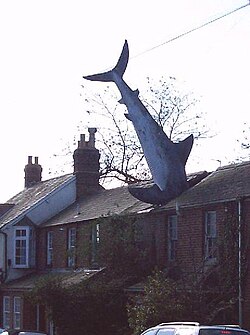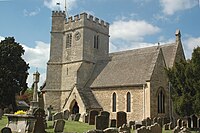Headington
| Headington | |
| Oxfordshire | |
|---|---|
 The Headington Shark | |
| Location | |
| Grid reference: | SP543070 |
| Location: | 51°45’35"N, 1°12’48"W |
| Data | |
| Post town: | Oxford |
| Postcode: | OX3 |
| Dialling code: | 01865 |
| Local Government | |
| Council: | Oxford |
| Parliamentary constituency: |
Oxford East |
| Website: | www.headington.org.uk |
Headington is an old Oxfordshire village which has become an eastern suburb of Oxford.[1] It is at the top of Headington Hill overlooking the city in the Thames valley below, and bordering Marston to the north-west, Cowley to the south, and Barton and Risinghurst to the east. The life of the large residential area is centred upon London Road, the main road between London and Oxford.
The name 'Headington' is derived from the Old English Hedan dun, meaning "Heda's hill".
Parish church

The parish church, St Andrew's was built in the middle of the 12th century and enlarged in the 13th century.[2][3] The bell tower was started in the 13th or 14th century[3] and completed in about 1500.[2]
St Andrew's was repaired in the 17th and 18th centuries.[2] The Gothic Revival architect John Chessell Buckler restored the building[2] and lengthened the nave in 1862–1864.[2][3]
History
The site of Headington shows evidence of continued occupation from the Stone Age, as the 2001 field excavations in Barton Lane found, suggesting a date in the 11th century BC. Pottery was found on the Manor Ground, suggesting an Iron Age settlement there in the 7th century BC. Roman kilns from about 300 have been found, including one now on display at the Museum of Oxford. Anglo-Saxon burial remains from about 500 have also been discovered.
This was the site of a palace or hunting lodge of the Kings of the Mercians. In a charter of 1004, Æthelred the Unready, "written at the royal ville called Headan dune", gave land in Headington to St Frideswide's Priory, which included the quarry and the area around it.
King Henry I granted a chapel at Headington to the Augustinian canons regular of St Frideswide's Priory, when the priory was founded in 1122.[2]
Headington developed rapidly in the early 20th century, significant amounts of housing developing around the mediæval village, now known as Old Headington, around the original parish church of St Andrew. In 1929 it was added municipal jurisdiction of the City of Oxford.[4]
'New Headington' refers to some of the area on the south side of the London Road, originating as a late 19th-century suburb.[5] Other neighbourhoods of the modern Headington suburb include Highfield, Quarry, and Headington Hill.[6]
The City of Oxford Silver Band began as the Headington Brass Band having been founded in the 19th century.
Headington today
Headington has a large and growing population.[7] Headington's main employment sectors are medicine, education, and research. In the centre of Headington are a number of shops, pubs, cafés, restaurants, and other services. The area also includes the main campus of Oxford Brookes University, Ruskin College (which moved in its entirety from central Oxford to its Headington site in 2012), and the city's main hospitals, including the John Radcliffe, Nuffield and Churchill.
Headington's most famous modern landmark is The Headington Shark, made by John Buckley for local broadcaster Bill Heine in 1986: it is a huge fibreglass shark that projects eccentrically from the roof of an ordinary terraced house as if it had crashed out of the sky.
Headington has a number of green spaces including Headington Hill Park, Bury Knowle park and South Park. Close by is Shotover Hill, a heath and woodland area with views over Oxfordshire, and listed as a Site of Special Scientific Interest. The Warneford Meadow a wild grassland, bought in 1918 by public subscription for the adjacent Warneford Hospital, has been registered as a Town Green and has thus escaped development.
Outside links
| ("Wikimedia Commons" has material about Headington) |
References
- ↑ Hibbert, Christopher, ed (1988). "Headington". The Encyclopaedia of Oxford. Macmillan. pp. 166–167. ISBN 0-333-39917-X.
- ↑ 2.0 2.1 2.2 2.3 2.4 2.5 Lobel, 1957, pages 157–168
- ↑ 3.0 3.1 3.2 Sherwood & Pevsner, 1974, page 336
- ↑ Stephanie Jenkins (7 August 2010). "Miscellaneous History: History of policing". History of Headington, Oxford. http://www.headington.org.uk/history/misc/police.htm.
- ↑ Stephanie Jenkins. "New Headington Village". Headington history: Streets. http://www.headington.org.uk/history/streets/new_headington/index.html.
- ↑ Stephanie Jenkins. "Headington Streets". Headington history: Streets. http://www.headington.org.uk/history/streets/index.html.
- ↑ "oxford.gov.uk". https://www.oxford.gov.uk/download/downloads/id/.../ward_profile-headington.pdf.
- Bloxham, Christine; Shatford, Susanne (1996). The Changing Faces of Headington: Book One. Witney: Robert Boyd Publications. ISBN 1-899536-05-1.
- A History of the County of Oxford - Volume 5 pp 157-168: Parishes: Headington (Victoria County History)
- Nikolaus Pevsner: The Buildings of England: Oxfordshire, 1974 Penguin Books ISBN 978-0-300-09639-2
